Have you ever felt that sinking feeling after launching your online course? You know—the one where your amazing content sits there waiting for students, but enrollment numbers aren't quite what you expected? Trust me, I've been there, and so have countless other course creators.
Here's the reality: creating a great online course is only half the battle. Online learning is the fastest-growing market in the education industry, having grown 900% since 2000. With millions of people taking courses every day, it’s clear that demand is super high – but so is competition.
But don't worry—you don't need superhuman powers (or marketing prowess) to succeed.
Whether you're:
A first-time course creator wondering where to start
An experienced educator struggling to reach more students
Or someone who's tired of the "if you build it, they will come" myth
This guide will walk you through proven strategies to market your online course effectively. We'll cover everything from foundational techniques that cost nothing but time, to advanced tactics that can scale your course business.
Why Marketing Matters for Your Online Course
Creating a great online course is like writing a brilliant book - if it sits on a shelf where no one can see it, it won't help anyone. And in today's $300 billion e-learning market, simply having good content isn't enough to get noticed.
The truth is, most online courses earn less than $1,000 in total revenue. Not because they lack quality, but because potential students never find them. Your expertise and hard work deserve better than that.
Marketing isn't about pushing your course onto people who don't need it. It's about building clear pathways that guide the right students to your virtual classroom. It's about showing up where your future students are already looking for answers.
Good marketing helps you:
Think of marketing as having meaningful conversations about how you can help solve problems. When done right, it feels less like selling and more like serving. Your future students are out there right now, searching for solutions you've already created.
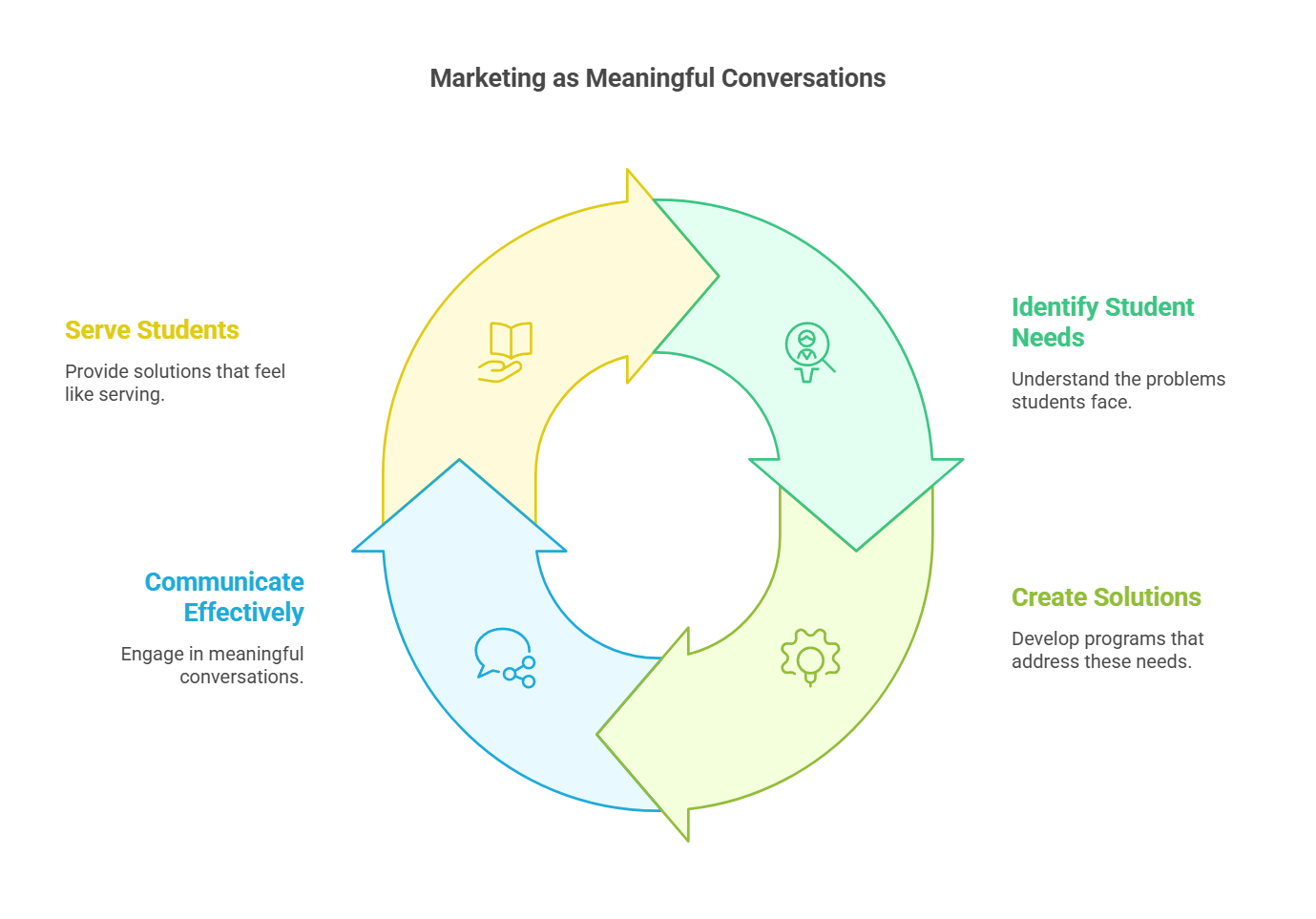
The strategies in this guide will help you bridge the gap between your course and the students who'd benefit most from it. Practical, proven approaches you can start using today.
Before We Start: Are You Using the Right Course Tools?
Before we dive into marketing strategies, let's talk about something that can make or break your success: your course platform. You could have the best marketing plan in the world, but if your course delivery feels clunky or unprofessional, students won't stick around - let alone recommend you to others.
Think of your course platform like a physical classroom. Students need:
- Easy navigation to find their lessons
- Reliable access to course materials
- A smooth, professional learning experience
- Clear progress tracking
- Mobile-friendly viewing options
This is why I recommend Thrive Apprentice for course creators. Unlike basic WordPress plugins or complicated all-in-one platforms, Thrive Apprentice strikes the perfect balance between professional features and ease of use. It lets you focus on teaching while handling the technical heavy lifting.
What makes Thrive Apprentice stand out:
- Clean, distraction-free learning environment
- Dynamic course content protection
- Progress tracking that keeps students motivated
- Full integration with WordPress
- Complete control over your course design
Most importantly, Thrive Apprentice feels premium to your students without breaking your budget. When students enjoy using your platform, they're more likely to complete your course and recommend it to others - making your marketing efforts more effective.
Pre-Launch Strategies: Laying the Groundwork for Success
Most course creators jump straight into launch mode, eager to start selling. But successful courses often get their foundations right first. The work you do before your launch can mean the difference between steady sales and crickets.
Think of pre-launch like preparing for a big road trip. You wouldn't just hop in the car and start driving, right? You'd check your map (or configure your GPS), fill up with gas, and make sure you're headed in the right direction. The same principle applies to launching your course.
In this section, we'll look at the key steps to take before you hit that launch button. These strategies will help you understand your market, refine your offer, and build excitement among your future students.
1. Identify Your Target Audience
Many course creators make the mistake of saying their course is "for everyone." But trying to speak to everyone means you'll connect with no one. Let's get clear on who will benefit most from your knowledge.
Start by asking yourself:
- What level of experience should your students have?
- What specific problems keep them up at night?
- What have they already tried to solve these problems?
Next, find out where your potential students spend their time online. Browse Facebook groups, subreddits, LinkedIn discussions, and Instagram hashtags related to your topic. Pay attention to the questions they ask and the language they use.
Pro tip
One of the best ways to segment your website visitors and find potential students is with a quiz or an online survey. If you want to learn how to create an engaging survey people will actually complete, check out this tutorial: How to Create a Survey in WordPress (Step-by-Step)
2. Validate Market Demand
Before investing weeks or months creating your full course, you'll want to make sure people are willing to pay for what you plan to teach. Here's how to check if there's real demand for your idea.
Look at what's already out there. Study courses similar to yours on platforms like Udemy, Skillshare, and Coursera. Read their reviews - both good and bad. What are students praising? What are they complaining about? These gaps in the market could be your opportunity.
Testing doesn't have to be complicated. Start small with:
- A free workshop teaching one specific aspect of your topic
- A waitlist page describing your upcoming course
- A quick PDF guide solving one pressing problem
Tools like Google Trends and Exploding Topics show you exactly what people are searching for in your niche. For example, if you're creating a photography course, you might discover that "iPhone portrait photography" gets more searches than "DSLR basics."
🎯 Pro Tip: Watch what people actually do, not just what they say. Someone signing up for your waitlist or downloading your free guide is a stronger signal than them simply saying they're interested.
3. Create a High-Converting Course Sales Page
Your sales page needs to do one job well: show potential students exactly how your course will help them. Think of it as having a one-on-one conversation with someone who's on the fence about enrolling.
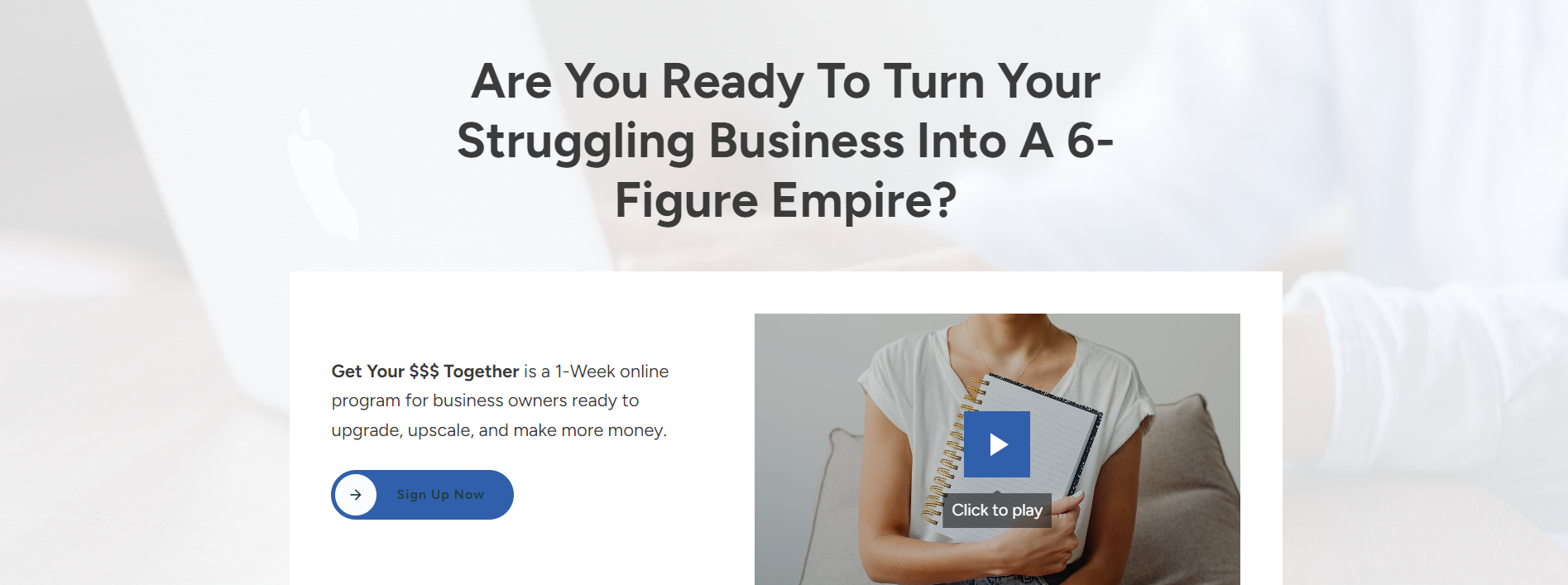
Start with a compelling headline that speaks to your student's goals. Instead of "Advanced Photography Course," try "Capture Professional-Quality Photos With Your Smartphone." The first tells them what you're teaching; the second tells them what they'll achieve.
Include these key elements on your page:
Thrive Tip: These tips are just the start. If you need a step-by-step tutorial on how to create a course sales page that converts, this is the guide for you: How to Create an Online Course Landing Page (Step-by-Step Guide)
And, of course, social proof matters. If you're just starting out, gather testimonials from:
- Beta testers who tried your material
- Colleagues who can vouch for your expertise
- Students from previous teaching experience
- Results from your own journey using these methods
If you need a tool to collect and manage testimonials from happy students, I have the perfect tool recommendation for you: Thrive Ovation. This WordPress plugin makes it really easy to collect testimonials, manage them in one space, and display them on the right posts and pages.
And if you need help with learning how to ask for testimonials without feeling awkward, this guide can show you how.
💡 Out-of-Box Strategy: The Course Critics Panel
Instead of guessing what might hold students back, pay 5-10 people from your target audience to actively look for problems with your course. Give them early access and specific instructions: "Find everything that confuses you, bores you, or makes you want to quit."
Their objections become your roadmap for improvements, and more importantly, they reveal the exact language your potential students use when voicing doubts. These raw insights often make the best marketing copy because they show you've addressed real concerns, not just imagined ones.
Think of it as "objection mining." Pay each critic $50-100 for their time, and you'll likely save thousands in failed marketing attempts. Plus, if you win over your toughest critics, they often become your most vocal supporters.
Content Marketing: Attract Students by Providing Value
Picture walking into a bakery. Before buying a whole cake, you might try a free sample. Content marketing works the same way. It gives people a taste of what you offer and how you teach.
Good content shows potential students you know your stuff without having to say "trust me, I'm an expert." When you share useful tips and insights regularly, you build natural authority in your field. People start to see you as their go-to source for answers.
But here's the key: your free content should solve real problems, not just tease solutions behind a paywall. When readers or viewers get actual results from your free material, they'll be more likely to invest in your paid course for deeper learning.
Let's look at specific ways to create content that attracts and engages your future students.
4. Start a Blog or YouTube Channel
Blogging and YouTube both offer ways to share your knowledge, and you don't need to choose just one. Each platform helps you reach students who prefer different ways of learning.
A blog works well for:
- Detailed how-to guides
- Step-by-step tutorials
- Resource lists and tools
- In-depth explanations
Thrive Tip: Not sure of what blog platform to choose? Take a look at this breakdown of the top blog platforms for creators and business owners.
YouTube lets you:
- Show instead of just tell
- Build a more personal connection
- Reach viewers through YouTube search
- Demonstrate techniques in action
Pick topics that answer real questions in your field. If you teach digital photography, you might write about "fixing grainy indoor photos" or make a video about "camera settings for sunset shots." These specific problems often make the best content.
When writing or filming, focus on one clear takeaway per piece of content. Give your audience something they can use right away, even if it's just a small win. This builds confidence in your teaching ability.
5. Create Free, High-Value Content
Free content doesn't mean giving away your entire course. Think of it as serving appetizers that make people eager for the main course. Your goal is to help people get a quick win while showing them there's more to learn.
Mini-ebooks and downloadable PDFs work great as standalone resources. A photographer might offer "10 Camera Settings Cheat Sheets," while a business coach could share "Client Email Templates That Get Responses." Keep these focused and practical.
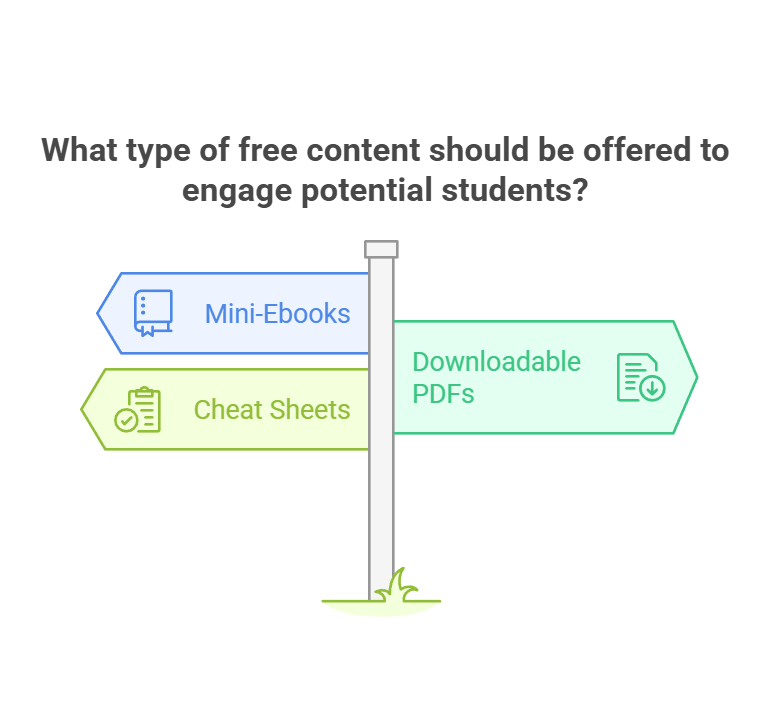
Email courses let you deliver bite-sized lessons directly to people's inboxes. A 5-day series works well - long enough to provide value, short enough to keep people engaged. Each email should build on the last while leaving readers curious about what's next.
Behind-the-scenes previews give people a glimpse of your teaching style and course quality. Share a favorite lesson clip or walk through how you solve a specific problem. This helps potential students picture themselves learning from you.
Pro tip
Free content is often best offered as a lead magnet - a downloadable item that you provide in exchange for your audience's contact information. The key to acing this strategy is in how you deliver your lead magnet, and this tutorial can show you how: How to Deliver a Lead Magnet (+Key Tips)
6. Tap Into Email Marketing
Email is where casual followers become committed students. Unlike social media, where posts disappear in crowded feeds, email gives you a direct line to people who've shown interest in what you teach.
Start by sharing helpful content that builds on your lead magnet. If someone downloaded your "Beginner's Guide to Watercolor," your first few emails might include quick painting tips, color mixing basics, or common mistakes to avoid.
Here's a simple approach to email content:
- Share a quick tip they can use today
- Tell a story about a problem you helped solve
- Point them to your free blog posts or videos
- Mix in personal experiences that relate to their goals
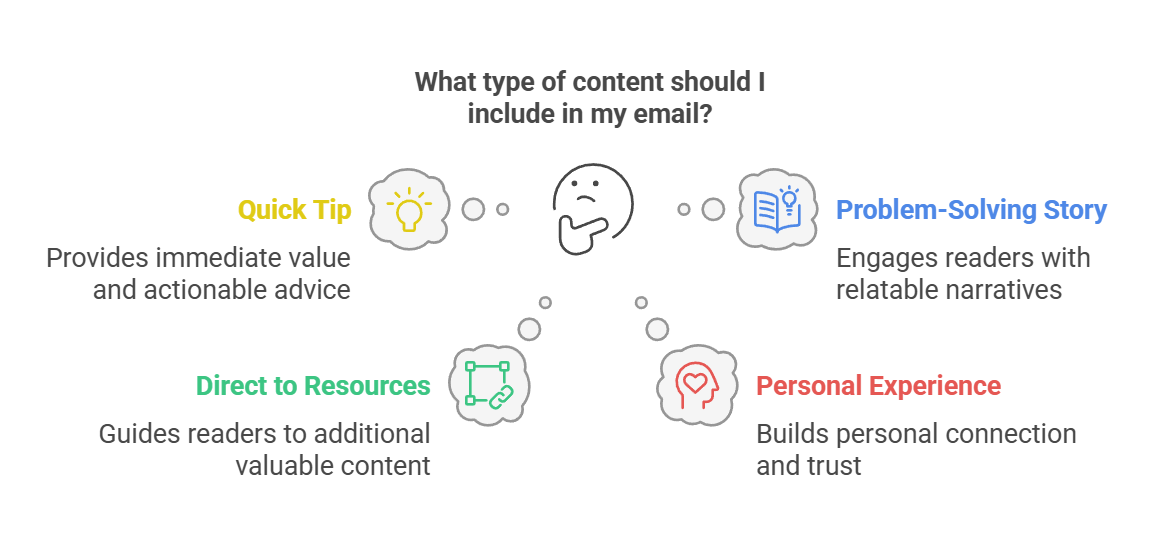
When it comes to selling your course, timing matters. Let your subscribers get to know you first. Share stories about your own learning journey or student success stories. When you do mention your course, focus on how it helps solve specific problems your readers have mentioned.
🎯 Pro Tip: Don't rely too heavily on discounts. While limited-time offers can work, building genuine interest in your course creates longer-lasting results than chasing quick sales.
💡Out-of-Box Strategy: The "Failure Friday" Series
Turn your past mistakes into powerful marketing content by running a weekly "Failure Friday" series. Each week, share a real mistake you've made in your field - the bigger the blunder, the better. Maybe you lost a client by underpricing, broke an expensive piece of equipment, or launched a product that totally flopped. Tell the story, explain what went wrong, and most importantly, break down exactly how you fixed it or what you learned.
This approach works because it flips traditional "expert positioning" on its head. Instead of presenting yourself as infallible, you're showing the messy reality of learning your craft. Students connect with this authenticity, and they'll often think, "If they recovered from that mistake, maybe I can too." Plus, these stories make excellent social media content - people tend to share posts that make them think, "At least I'm not the only one who's done this!"
Leverage Social Media: Engage & Grow Your Audience
Social media works best when you treat it like a coffee shop, not a marketplace. It's a place to chat, share ideas, and build relationships with future students. The people who follow you want to learn from your experience, not just see links to your course.
Many course creators burn out trying to be everywhere at once. Instead of spreading yourself thin across every platform, pick one or two where your ideal students already hang out. Show up regularly, join conversations, and share bits of knowledge that make people stop scrolling.
Remember: good social media marketing rarely feels like marketing at all. Let's look at how to build a presence that attracts students naturally.
7. Choose the Right Platforms
Each social media platform has its own language and culture. Success comes from matching your content style to the platform where your future students spend their time.
Instagram and TikTok shine when you can teach visually. Quick tutorials, daily tips, and behind-the-scenes glimpses work well here. A chef might show 30-second cooking techniques, while a graphic designer could share before-and-after project reveals.
LinkedIn rewards expertise and professional insight. Share industry observations, comment on trends, or post detailed case studies. This platform works especially well for business, career, and professional development courses. The key is joining discussions and adding thoughtful comments, not just posting and running.
Facebook Groups offer a way to build deeper connections. You can either:
- Create your own group focused on your topic
- Participate actively in existing groups where your audience hangs out
Pro tip
Take this strategy several steps further by adding a social media feed to your website. It's the best way to connect your social platforms with your website, so new visitors can see what you're up to outside of your blogs and landing pages.
And the best tool to make this happen is Smash Balloon. This tool makes it easy to embed social feeds on your website pages and posts -- no coding needed!
8. Use Live Sessions to Engage with Your Followers
Social media is noisy. Standing out means mixing up your content to keep followers interested and coming back for more. Here's what works well across most platforms.
Live Q&A sessions give you face-to-face time with potential students. Go live weekly or monthly to answer questions, solve common problems, and show your teaching style in action. These sessions often lead to great course content ideas too - pay attention to which questions keep coming up.
Behind-the-scenes content helps people feel connected to you and your course. Share snippets like:
- How you prepare your lessons
- Updates you're making to the course
- Your own learning moments and discoveries
- Quick tips from upcoming modules
Share student wins when you have them. Nothing sells your course quite like real people getting real results. Even small victories matter - someone finishing their first project or having an "aha" moment makes great social content.
🎯 Pro Tip: Short-form video grabs attention fast. Try turning your best tips into 30-60 second videos for TikTok or YouTube Shorts. A quick "here's how I solved this common problem" often performs better than polished, promotional content.
💡 Unique Tactic: The "Reverse Testimonials" Project
Most testimonials show the finish line - "I took this course and now I'm successful!" But potential students often connect more deeply with stories from people still struggling with the same challenges they face. Here's how to flip the testimonial concept on its head.
Find 3-5 people who fit your ideal student profile but haven't taken your course. Interview them on camera about their current struggles, frustrations, and failed attempts to solve their problems. Be real and detailed: "I've spent $300 on equipment I never use" or "I keep losing clients because I can't price my services right." These raw, honest conversations resonate because they mirror your audience's current situation.
Then, offer these people your course for free in exchange for a follow-up interview. The contrast between their "before" and "after" stories creates compelling proof that your course works. Plus, you get invaluable insights into the exact language your potential students use to describe their challenges.
🎯 Pro Tip: These interviews often reveal pain points you hadn't considered, helping you improve both your course content and marketing messages.
Webinars & Live Events: Show Your Expertise in Real Time
Live events create energy that recorded content can't match. When people see you teaching in real-time, answering questions on the fly, and sharing insights naturally, they get a true sense of what learning from you might be like.
Think of webinars and live events as mini-classes. They give you a chance to prove you know your stuff while giving attendees a taste of success. When someone learns something useful during your free session, they're more likely to think, "If I got this much value from an hour, imagine what the full course offers."
The key is making these sessions genuinely helpful, not just thinly-veiled sales pitches. Let's look at how to run live events that leave people excited to learn more from you.
9. Host Webinars or Free Training Sessions
A good webinar feels like a class, not a sales meeting. Pick one specific topic you can teach well in 45-60 minutes. For example, a Facebook ads expert might teach "How to Write Ad Copy That Gets Clicks," while a yoga instructor could show "3 Poses to Fix Lower Back Pain."
Structure your session with these elements:
- A quick win in the first 10 minutes
- Clear steps attendees can follow along with
- Time for live Q&A
- Examples or demonstrations
- Action items people can try right away
Naturally mention your course near the end, showing how it builds on what they just learned. But keep the focus on delivering value - your teaching should do the selling for you.
Pro tip
Your webinars are only effective if people actually attend them. And to get that to happen, you need a solid webinar funnel. If you need assistance with setting one up, this tutorial can help: How to Create a Webinar Funnel on WordPress (Ultimate Guide).
10. Offer Free Mini-Courses or Samples
"But won't giving away content hurt my sales?" It's a common worry, but actually, the opposite is true. Free samples work like movie trailers - they give enough to hook interest while saving the best parts for the full experience.
A well-designed mini-course should:
- Solve one specific problem completely
- Show your teaching methods in action
- Leave students confident they can learn from you
- Hint at the deeper knowledge in your full course
For example, if you teach portrait photography, your mini-course might cover "Perfect Lighting with Window Light Only." Students get a complete skill they can use, while learning there's much more to portrait photography than just lighting.
Some proven formats:
- A single module from your main course
- A simplified version of a core technique
- A fundamental skill that leads to more advanced topics
Think of free content as an investment in trust. When students succeed with your free material, they're more likely to think, "If the free stuff is this good, the paid course must be even better."
Want to learn how to use a free course to drive more people to your paid courses? This tutorial can help.
🎯 Pro Tip: Create your mini-course once, then use it multiple ways. Turn your live webinar recording into an automated mini-course. Add it to your welcome email series. Use clips for social media. One piece of content, multiple trust-building tools.
Remember: You're not giving away your whole course - you're giving people a reason to want more.
Paid Advertising: Fast-Track Your Course Growth
Let's talk about paid ads - they're not magic, but they can speed up your course's visibility when done right. Think of organic marketing as planting a garden, while paid ads are like turning on a tap. Both can bring results, but paid ads can deliver them faster.
Most course creators start with organic methods, and that's smart. But once you know your course sells and you understand your audience, paid ads can help you reach more of the right people consistently.
Before you spend a dollar on ads, you should have:
A course that's already made some sales
Clear data on who buys and why
A sales page that converts visitors
A budget you're comfortable testing with
Let's look at the most effective ways to use paid advertising for course promotion, starting with the platforms that typically work best for course creators.
11. Best Paid Ad Strategies
Start small and test before spending big. Each ad platform has its strengths, and you'll want to find what works best for your specific course.
Facebook & Instagram Ads work well for interest-based targeting. You can reach people who follow competitors, engage with similar content, or fit your student profile. For example, if you teach guitar, you might target people who like specific guitar brands or music learning pages.
Google Ads catch people actively searching for solutions. Someone typing "learn digital marketing" or "best photography course" is already interested in learning. These ads often convert well because you're meeting people at the exact moment they're looking to learn.
YouTube Ads let you show up before relevant videos. If you teach cooking, your ad might play before popular recipe videos. This puts you in front of viewers already engaged with your topic. Keep these ads short and hook attention in the first 5 seconds.
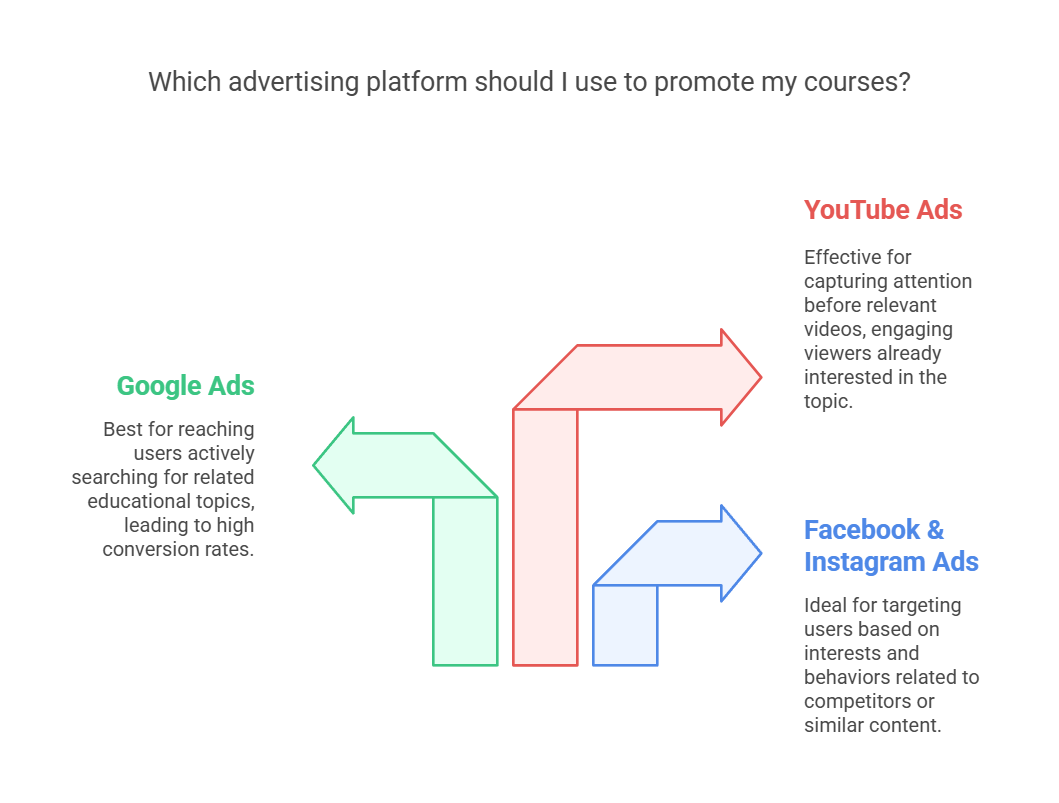
Retargeting shows ads to people who've already shown interest. These might be folks who:
- Visited your course page
- Watched your free content
- Downloaded your lead magnet
- Started but didn't finish checkout
🎯 Pro Tip: Start with $5-10 per day on one platform. Test different audiences and messages for a week before deciding whether to increase spending. Good ads usually show promise within the first few days.
Remember: The goal of your first ads isn't massive sales - it's collecting data about what resonates with your audience.
Build Partnerships & Affiliations: Expand Your Reach
Other course creators aren't always your competition - they can be your best allies. Smart partnerships help you tap into established audiences while giving fellow educators a way to serve their students better.
Think about the journey your students take. What do they need before they're ready for your course? What might they need after? These gaps are partnership opportunities. A meditation teacher might partner with a yoga instructor, or a web design course creator might team up with someone teaching SEO.
Good partnerships feel natural to everyone involved - the creators, their audiences, and most importantly, the students. Let's look at ways to build these relationships authentically.
12. Collaborate with Influencers
Influencer partnerships work best when they grow naturally from genuine connections. Start by building real relationships with other creators in your space. Comment thoughtfully on their posts, share their content, and engage with their work before pitching partnerships.
Look for influencers who:
- Share your values and teaching philosophy
- Have an audience that matches your ideal students
- Create content complementary to yours
- Regularly engage with their followers
When reaching out, focus on mutual benefit. Instead of just asking them to promote your course, suggest ways to create value together:
- Guest teaching in each other's programs
- Co-hosting a workshop or webinar
- Creating exclusive bonus content
- Offering special packages for their audience
If you're offering affiliate commissions, make it easy for partners to succeed:
- Provide ready-to-use promotional content
- Create custom landing pages for their audience
- Share what messaging works best
- Offer competitive commission rates (30-50% is standard)
🎯 Pro Tip: Start with micro-influencers (10,000-50,000 followers) in your niche. They often have more engaged audiences and are more likely to form meaningful partnerships.
13. Team Up with Complementary Course Creators
Look for course creators who serve the same audience but teach different skills. If you teach Instagram marketing, you might partner with someone who teaches email marketing or content writing. Your students benefit from access to related skills, and both courses get exposure to new audiences.
Some effective partnership ideas:
- Bundle your courses at a special rate
- Create exclusive bonus modules for each other
- Host joint Q&A sessions
- Share student success stories across platforms
For example, a food photography instructor might team up with:
- A food styling course creator
- Someone teaching recipe development
- A social media expert for food bloggers
- A course on starting a food blog
🎯 Pro Tip: Browse course marketplaces to find potential partners. Look for creators whose students often ask about topics you teach. These natural connection points make partnerships feel authentic.
When approaching potential partners, focus first on how you might help their students. Offer to create a special resource or teach a guest lesson before discussing how they might promote your course.
Remember: The best partnerships feel like a natural extension of what you both already offer, not a forced collaboration.
SEO & Organic Growth: Get Found on Google
While paid ads bring quick results, SEO is like planting seeds that grow into steady traffic over time. Every day, thousands of people search Google for courses like yours. With the right approach, you can show up in these searches without paying for ads.
SEO might feel technical, but at its core, it's about answering people's questions well. When someone types "how to learn photography" or "best digital marketing course," they're looking for helpful, trustworthy information. Your job is to provide it.
Don't expect overnight results - good SEO typically takes 3-6 months to show real impact. But unlike paid advertising that stops when you stop spending, SEO keeps working for you long after you've published the content. Let's look at how to build this lasting traffic source.
14. Optimize for Search Engines
People looking to learn new skills often start with Google. When your content shows up in these searches, you get free, targeted traffic from students actively looking to learn what you teach.
Focus on specific phrases that show buying intent:
- "how to learn [your topic]"
- "best course for [specific skill]"
- "[topic] for beginners"
- "[topic] certification"
Write content that answers common questions in your field. A photography course might target:
- "how to shoot in manual mode"
- "best camera settings for portraits"
- "photography basics for beginners"
Create three types of content:
- How-to guides that solve specific problems
- Comparison posts that help people make decisions
- Resource lists that gather helpful tools and tips
Building quality backlinks takes time but pays off. Some natural ways to get them:
- Guest post on industry blogs
- Get interviewed on podcasts
- Create shareable resources other sites want to link to
- Participate in expert roundups
🎯 Pro Tip: Consider creating a free mini-course on Udemy. While keeping your main course on your platform, use Udemy's search traffic to introduce students to your teaching style. Include a special offer for your premium course in the final lesson.
Remember: SEO is a long game. Focus on helping readers first, and the rankings will follow. This guide on creating SEO-friendly pages and posts can guide you further.
If you have a WordPress website, then I strongly recommend that you use an SEO plugin to get key tips on how to optimize your pages and posts to give them a better chance to rank well. My go-to recommendation is All in One SEO, but if you'd like to check out more options then take a look at this breakdown of top SEO plugins.
Offer Incentives & Risk-Free Guarantees
Buying an online course feels risky for many students. They wonder: "Will this actually help me?" "Is it worth the money?" "What if it's not what I expected?" Smart incentives and guarantees help address these natural concerns.
But this isn't about using pushy sales tactics or artificial scarcity. It's about giving potential students the confidence to invest in their learning. When you truly believe in your course, standing behind it with genuine guarantees and thoughtful bonuses shows that confidence.
Let's look at ways to reduce buying friction while maintaining the value of your course. The goal is to help students feel secure in their decision, not pressure them into buying.
15. Incentives That Work
Good incentives add value while respecting your course's worth. They should feel like a genuine reward, not a desperate attempt to make a sale.
Early Bird offers work best when they're genuinely exclusive to your first students. Give these pioneers a fair price break, but ask for their partnership in return. Your early students can provide detailed feedback, share their progress, and help you refine the course. Their input makes the course better for future students, and their success stories become powerful social proof.
Smart ways to structure your early bird offer:
- First 20 students get 30% off plus a group kickoff call
- Launch week students receive private community access
- Founding members get quarterly private check-ins
When creating bundles, focus on additions that help students implement what they learn. A course teaching social media management might include monthly template packs, caption frameworks, or analytics spreadsheets. For business courses, adding group coaching calls gives students a chance to get specific questions answered. The key is choosing extras that speed up success, not just padding the offer.
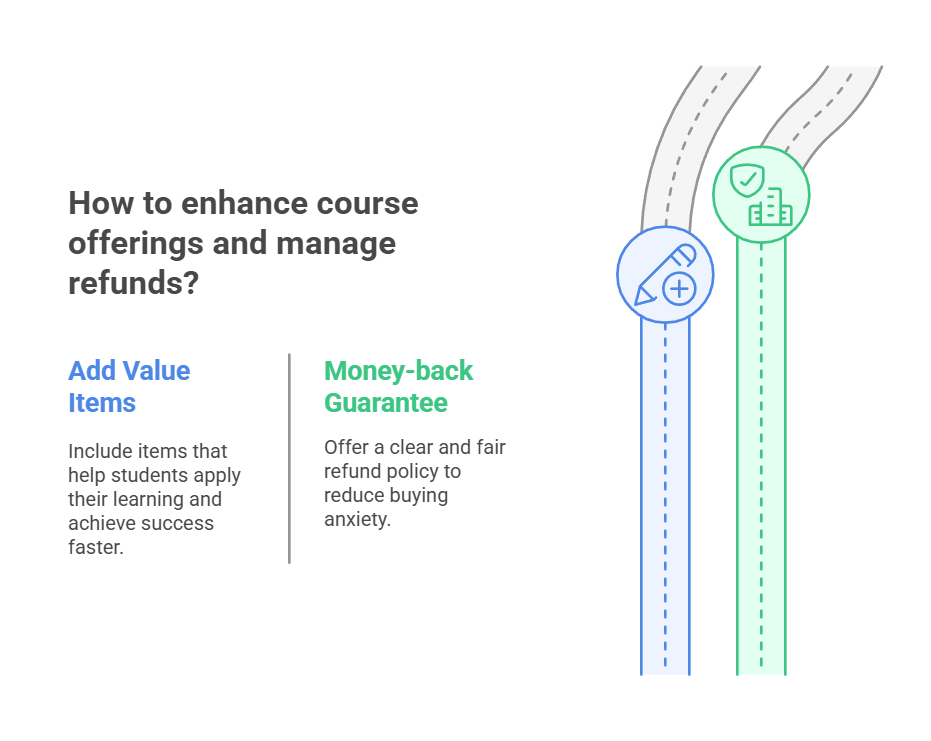
Money-back guarantees reduce buying anxiety, but they need clear terms to protect both you and your students. Rather than a simple "30-day guarantee," spell out what constitutes a fair try of your course. For example: "Complete the first three modules, submit your assignments, and if you're not seeing results, we'll refund your investment." This approach ensures students give the material a real chance while protecting you from refund abuse.
Effective guarantee frameworks:
- Action-based: "Complete Module 1 and submit your work"
- Time-based with conditions: "30 days + show your progress"
- Milestone-based: "Until you land your first client"
🎯 Pro Tip: Consider offering time-sensitive bonuses instead of discounts. When you include a bonus like "First 20 students get a private coaching call" or "Sign up this week for lifetime access to our monthly Q&A sessions," you maintain your course's perceived value while giving people a reason to enroll now.
Time-sensitive offers are more effective with countdown timers -- and those work best on your website. Thrive Ultimatum is the perfect tool to get this job done and increase conversions for your online courses.
And this guide shows you how to set countdown timers on your website to get more people to convert: How to Add a Countdown Timer in WordPress (Step-by-Step).
Remember: The best incentives focus on helping students succeed, not just on getting them to buy. Every bonus or guarantee should move them closer to their learning goals.
Advanced Marketing: Scaling Your Success
Once you've got your core marketing working - steady enrollments, happy students, and positive feedback - it's time to think bigger. Scaling isn't just about reaching more people; it's about working smarter to serve more students without burning out.
Think of scaling like upgrading from a home kitchen to a restaurant. You'll need systems that run smoothly, reliable ways to bring in new students, and methods to maintain quality as you grow. The strategies in this section work best when you have some success to build on.
Before diving into these advanced tactics, make sure you have:
A proven course that students consistently complete and praise
Clear data on what marketing efforts work best
Systems for handling student questions and support
Enough revenue to reinvest in growth
Let's look at how to take your course marketing to the next level while maintaining the quality your students expect.
16. Build an Automated Sales Funnel
A good sales funnel works like a friendly guide, helping people move naturally from discovering you to enrolling in your course. Instead of constantly chasing new students, you create a path that nurtures people automatically.
Start with a clear journey map. Someone might first find you through a helpful blog post or video. From there, they get value from your free content, join your email list for a useful resource, and eventually learn about your course when it makes sense for them.
A basic but effective funnel might look like this:
- Valuable blog post or video (addressing a specific problem)
- Free resource download (diving deeper into the solution)
- Welcome email series (building trust with helpful content)
- Course invitation (when they're ready to take the next step)
Sales funnels might sound complicated or scary, but they're actually really easy to set up -- especially when you have the right tools to get the job done. My go-to builder is Thrive Architect because it has a super straightforward drag-and-drop editor, a large selection of professionally-designed templates to design my funnel pages, and additional design elements to make each page truly my own.
And it gets better. We have a couple of tutorials, focused on building sales funnels, to help creators set them up the right way:
Your email sequence should tell a story over time. Start by delivering the free resource they requested, then share additional tips, student success stories, and answers to common questions. When you do mention your course, frame it as the natural next step for someone wanting to go deeper.
Example email flow:
- Day 1: Deliver promised resource, quick win
- Day 3: Additional tip they can use right away
- Day 5: Student success story related to their goals
- Day 7: Common challenge and how your course solves it
- Day 10: Special offer or invitation to join
🎯 Pro Tip: Watch where people drop off in your funnel. If lots of people download your free guide but few open the follow-up emails, you might need to adjust your email content or timing. Your funnel should feel helpful, not pushy.
Bonus: Use Your Analytics to Improve Your Courses and Marketing
Numbers tell stories about what's working and what isn't. While you don't need to become a data scientist, understanding a few key metrics helps you make smarter marketing decisions. Think of analytics like a GPS for your course business - it shows you where you're making wrong turns and helps you find better routes to success.
Start with these essential metrics that matter most:
Core Marketing Metrics to Track:
- Email engagement: Open rates (aim for 20%+) and click rates (aim for 2-5%)
- Sales page performance: Time on page, scroll depth, and bounce rate
- Student journey: Where sign-ups come from and how long they take to buy
- Content effectiveness: Which blog posts, videos, or emails drive the most conversions
- Course completion: What percentage of students finish each module
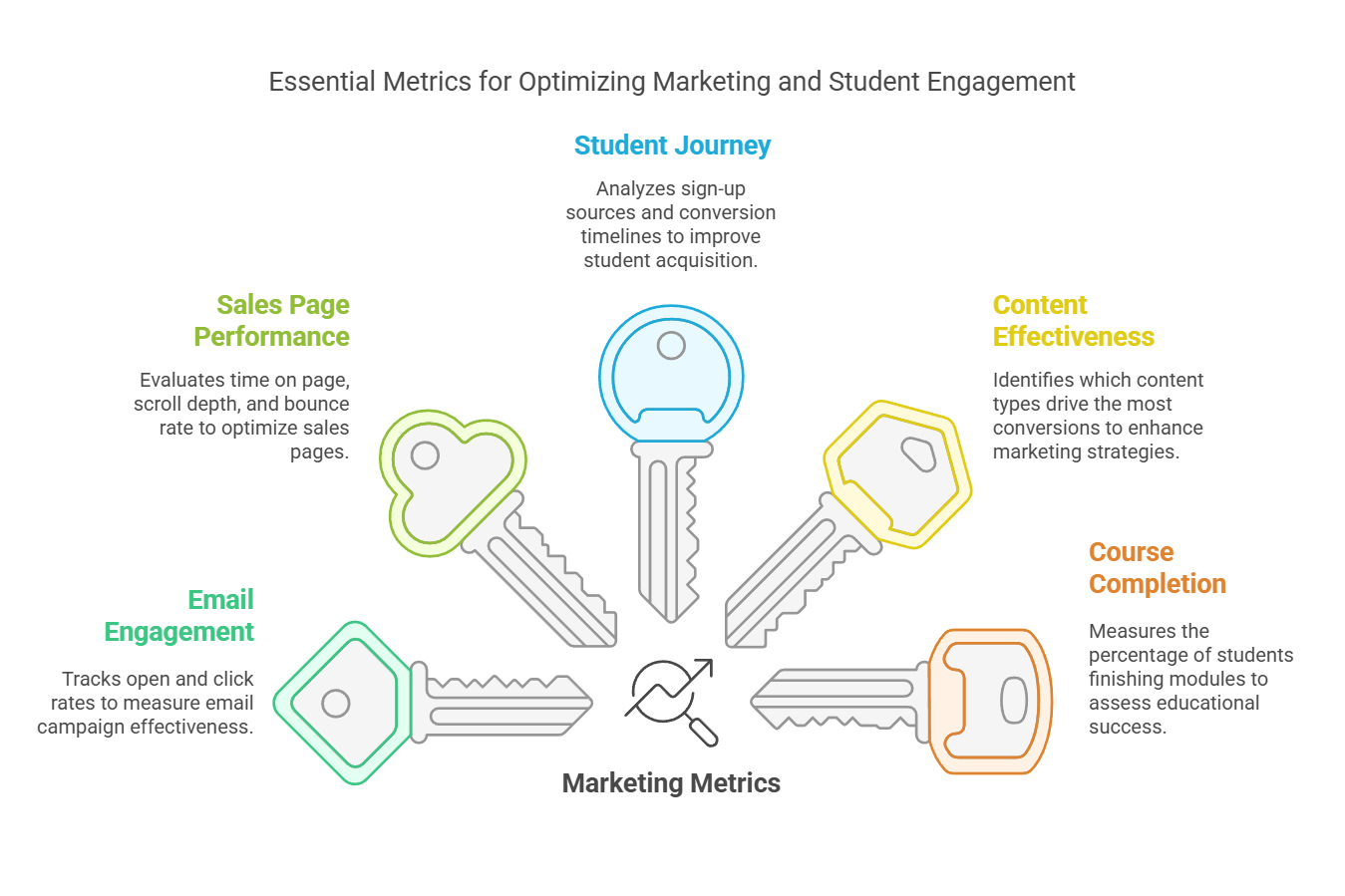
Pay special attention to where people stop taking action. For example, if your sales page gets lots of traffic but few sales, the problem might be your messaging, not your traffic sources. If students consistently drop off at module three, that module might need restructuring.
For paid advertising, tracking gets more detailed. Watch your cost per lead (CPL) and cost per acquisition (CPA) like a hawk. If you're spending $50 to acquire a student for a $200 course, you'll need very low delivery costs to make a profit. Test different:
- Ad creatives (images, videos, copy)
- Audience segments
- Placement options
- Times of day and days of week
When making improvements, follow the "one change, one week" rule. If you change your sales page headline, wait a week before changing anything else. This clarity helps you know exactly what's working or not.
My recommendation is to set up Google Analytics on your website. This tool provides all the key marketing metrics you need to track, so you can evaluate everything from one spot. And don't worry, there's an easy way to install this tool and navigate it -- MonsterInsights.

This tool offers a one-click way to connect Google Analytics to website as well as easy-to-understand reports you can go through in a few seconds. Want to learn how to set it up? Use this guide.
Remember: The goal isn't to hit industry-standard numbers but to keep improving your own. Even a 1% increase in conversion rate can mean significant revenue over time. Focus on trends rather than absolute numbers, and always ask, "How can this data help me serve students better?"
How to Market Your Course Online: Wrapping Up
Marketing your online course isn't a one-time push - it's an ongoing journey of testing, refining, and adapting. The good news? You don't need to implement every strategy at once. Start with what feels manageable and build from there.
Here's a practical way to begin:
- Pick three strategies from this guide that match your current situation:
- If you're just starting: Focus on pre-launch, content marketing, and email list building
- If you have some students: Leverage testimonials, partnerships, and SEO
- If you're ready to scale: Explore paid ads, automation, and advanced analytics
- Give each strategy at least 30 days of consistent effort. Marketing works best when you give it time to gain traction. Keep track of what works and what doesn't - these insights will guide your next moves.
- Stay connected with your students. Their feedback, questions, and success stories will inspire your best marketing ideas. Often, the most effective marketing comes from simply listening to your audience and addressing their needs.
Your course has the potential to change lives - now it's time to help the right people find it.
🎯 Quick Action Step: Choose one strategy from this guide and implement it this week. Small actions, taken consistently, lead to significant results.
Questions about marketing your course? Drop them in the comments below - we're here to help!


